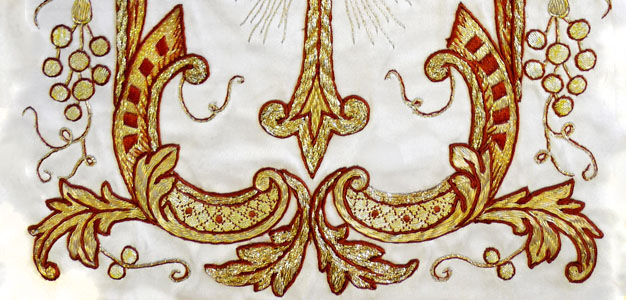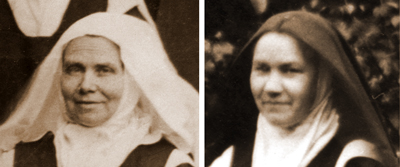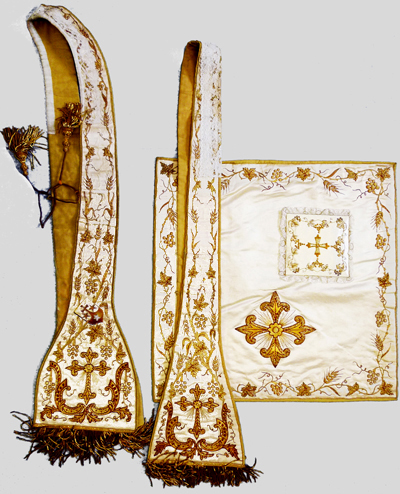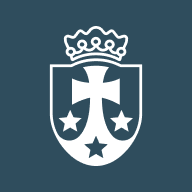
The work of ornaments is both sewing and a work of art because at the time, all priestly ornaments were enriched with embroidery, lace, even precious stones, to magnify the beauty of the liturgy. Embroidery was part of the education of wealthy girls and many entered the Carmel with a good foundation, but the work of ornaments was the responsibility of specialists.
The best embroiderers of Thérèse's time were Sr Saint-Vincent de Paul (see letter from Mother Agnès to Céline /September 1893), and Sister Saint-Jean-Baptiste, who knew how to embroider admirably (see his biography).
Before the final assembly of the ornament, they worked on the sections to be embroidered, for example those which would make up the orfrois, these decorative facings on the back and front of the chasuble.


The making of the ornament began with the cut. It was necessary to cut the fabric into silk threads according to the pattern of the ornaments violin ( violin box) of the time. See the photos to the left and below of a very old ornament in the sacristy. The cut in the front is notched at the shoulders to allow easy elevation of the arms during the celebration of the mass.
It was also necessary to cut the lining, on which we threaded a very rigid canvas named buckram so that the ornament remains stiff during use. Buckram was used at the time to give a little hold to belts. Around the neck there is a collar, often in lace, to protect the neckline of the chasuble.
In the middle of the front along the length, there is an ornate facing, often embroidered, called orfroi. It appears on the back in the shape of a cross, then bearing a motif in the center of orfrois, as here, a Virgin and Child.
These facings are the most difficult job to do and take a lot of time. When they are completed, the assembly of the chasuble is completed.

The complete ornament included in the same fabric the stole around the neck and the handle around the arm (sort of small stole - on the left in the photo), as well as a corporal's purse (the corporal was folded in it) and a large veil for the chalice (on the right in the photo). It was a set to be made at the same time as the chasuble.
Below is an enlarged detail of the embroidery.


The ornaments were sold and brought in approximately 450 francs per year for the last three years of Thérèse's life. They were made to order.
The sisters made in Lisieux:
- altar linen: amices, purificators, corporals, stole towers, washbasins or manuterges, blades.
- albs and surplices: albs and alb cords, short-sleeved and long-sleeved surplices, sponsors' surplices.
- chasubles and their accessories, dalmatics and their stoles and maniples, copes.
All according to the standards of liturgical manual by Leon Le Vavasseur.
The work of ornaments also includes their care: how to mend the tulle, make the seams to the lace, etc.


